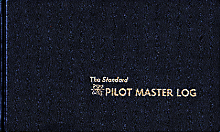



Standard Pilot Master Logbook for Non-Pilots
The pen and paper logbook most used by professional pilots in my day was the "Standard Pilot Master Log". For non-pilots, this page is some kind of a basic reference guide to the logbook flight-time columns and their meaning to the pilot. Each page of the log is divided into two sheets. The column headings for the left sheet are shown above in the first image above, and the column headings for the right sheet are shown in the second image above.
Pilots aren't required by FAA regulations to record all their flight times, except for fight times, flight conditions, maneuvers, landings, instrument approaches, etc - details which they're required to document for purposes of meeting FAA requirements for pilot licenses, ratings, proficiency and recency. Most pilots just record all their flight time and details anyway.
The flight time recorded by the pilot is by make and model of aircraft flown, engine(s) and land/sea configuration, local or cross-country, day or night, instrument conditions simulated or actual, and as instructor, pilot-in-command or second-in-command. You'll notice many of the column headings are left open and can be labelled as suits the pilot recording his flight time.
A couple of the column heading acronymns I used in my logbook are: ASEL = "Airplane Single Engine Land", and AMEL = "Airplane Multi Engine Land".
This page is posted to give the non-pilot some clue as to what they're looking at in the logbook line item entry displayed at the top of each story page, so they can relate it to the story text that follows. Note: my pre-professional pilot flight times were recorded in a smaller student pilot logbook. They are the logbook line items pictured in the first series of stories. The logbook format is similar, but it has fewer columns for flight conditions and pilot time detail.
03-11-2023
-------------------------------------------------------------------